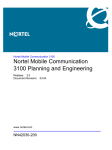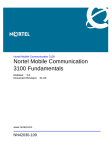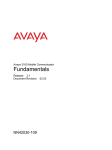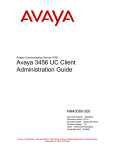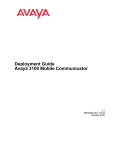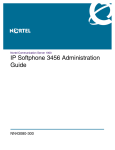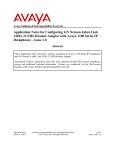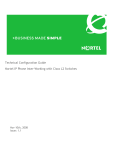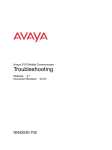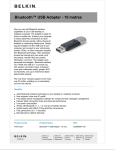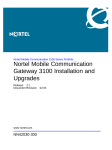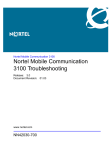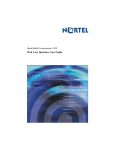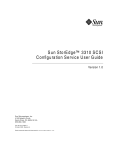Download Avaya Mobile Communication 3100 Planning and Engineering User's Manual
Transcript
Nortel Mobile Communication 3100 Nortel Mobile Communication 3100 Planning and Engineering Release: 3.1 Document Revision: 04.01 www.nortel.com NN42030-200 . Nortel Mobile Communication 3100 Release: 3.1 Publication: NN42030-200 Document release date: 2 October 2009 Copyright © 2007-2009 Nortel Networks. All Rights Reserved. While the information in this document is believed to be accurate and reliable, except as otherwise expressly agreed to in writing NORTEL PROVIDES THIS DOCUMENT "AS IS" WITHOUT WARRANTY OR CONDITION OF ANY KIND, EITHER EXPRESS OR IMPLIED. The information and/or products described in this document are subject to change without notice. Nortel, Nortel Networks, the Nortel logo, and the Globemark are trademarks of Nortel Networks. All other trademarks are the property of their respective owners. . . Features 5 Communication server requirements Other changes 5 References 5 7 MCC 3100 and MC 3100 Web UI network deployment 9 Data network requirements 10 MCG 3100 network deployment 12 BlackBerry deployment considerations (with BES) 12 BlackBerry (without BES), Nokia, and Windows Mobile deployment considerations 13 Network bandwidth requirements 13 Dialing plans and telephone numbers 14 Security requirements 16 Password protection 18 High availability 18 MCG 3100 and Enterprise Communication Server high availability 20 Capacity 22 Client device specifications 23 Gateway specifications 23 Port tables 23 MCC 3100 and MC 3100 Web UI licenses MCG 3100 licenses 29 CS CS CS CS 29 1000 deployment considerations 31 1000 Source Based Routing 32 1000 package requirements 32 1000 engineering for MC 3100 32 Nortel Mobile Communication 3100 Nortel Mobile Communication 3100 Planning and Engineering NN42030-200 04.01 2 October 2009 Copyright © 2007-2009 Nortel Networks. All Rights Reserved. . SIP Trunk configuration 35 Device Handoff configuration 37 CS 1000 feature interactions 38 CS 1000 capacity requirements 39 Trunk calculation: Method 1 40 Trunk calculation: Method 2 41 UEXT calculations 44 CS 1000 release and supported MC 3100 features Call Detail Recording 45 Direct outbound call 46 Call-Me-First outbound call 46 Incoming call 46 44 Nortel Mobile Communication 3100 Nortel Mobile Communication 3100 Planning and Engineering NN42030-200 04.01 2 October 2009 Copyright © 2007-2009 Nortel Networks. All Rights Reserved. . . The following sections detail what’s new in (NN42030-200) for Nortel Mobile Communication 3100 (MC 3100) Release 3.1. • • "Features" (page 5) "Other changes" (page 5) See the following sections for information about feature changes that impact this document: • "Communication server requirements" (page 5) For more information on all the new features, see (NN42030-109). MC 3100 Release 3.1 supports the following versions of Nortel Communication Server 1000 (CS 1000): • CS 1000 Release 5.5 — CS and SS: Deplist of February 3, 2009 or later — SPS: SU 5.50.12.006 or later • CS 1000 Release 6.0 — Only supported if the Nortel Mobile Communication Gateway 3100 (MCG 3100) runs SU130 or later. — latest deplist must be loaded CS 1000 package requirements are discussed in "CS 1000 package requirements" (page 32). Updated the reference list for new documents. Nortel Mobile Communication 3100 Nortel Mobile Communication 3100 Planning and Engineering NN42030-200 04.01 2 October 2009 Copyright © 2007-2009 Nortel Networks. All Rights Reserved. . New in this release October 2009 Standard 04.01. This document is issued to support Nortel Mobile Communication 3100 Release 3.1. July 2009 Standard 03.04. This document is issued to support Nortel Mobile Communication 3100 Release 3.0 and the Communication Server 2100 (CS 2100). Information regarding the CS 2100 is added. April 2009 Standard 03.03. This document is up-issued to reflect modifications made to support Nortel Mobile Communication 3100 Release 3.0. October 2008 Standard 03.02. This document is issued to support Nortel Mobile Communication 3100 Release 3.0. Updates were made to clarify use of the Nortel Enterprise Common Manager. September 2008 Standard 03.01. This document is issued to support Nortel Mobile Communication 3100 Release 3.0. April 2008 Standard 02.01. This document is issued to support Nortel Mobile Communication 3100 Series Portfolio Release 2.1. January 2008 Standard 01.11. This document is up-issued to support the Nortel Mobile Communication 3100 Series Portfolio on Nortel Communication Server 1000 Release 5.0 and Nortel Multimedia Communication Server 5100 Release 4.0. It addresses CR Q01806868. December 2007 Standard 01.10. This document is up-issued to support the Nortel Mobile Communication 3100 Series Portfolio on Nortel Communication Server 1000 Release 5.0 and Nortel Multimedia Communication Server 5100 Release 4.0. It addresses CR Q01798825. November 2007 Standard 01.09. This document is up-issued to support the Nortel Mobile Communication 3100 Series Portfolio on Nortel Communication Server 1000 Release 5.0 and Nortel Multimedia Communication Server 5100 Release 4.0. It addresses CR Q01773232 and Q01776937. October 2007 Standard 01.07. This document is up-issued to support the Nortel Mobile Communication 3100 Series Portfolio on Nortel Communication Server 1000 Release 5.0 and Nortel Multimedia Communication Server 5100 Release 4.0. It addresses CR Q01766011 and CR Q01768688. October 2007 Standard 01.05. This document is up-issued to support the Nortel Mobile Communication 3100 Series Portfolio on Nortel Communication Server 1000 Release 5.0 and Nortel Multimedia Communication Server 5100 Release 4.0. It addresses CR Q01756404. September 2007 Standard 01.03. This document is up-issued to support the Nortel Mobile Communication 3100 Series Portfolio on Nortel Communication Server 1000 Release 5.0 and Nortel Multimedia Communication Server 5100 Release 4.0. It addresses CR Q01743268. September 2007 Standard 01.01. This document is issued to support the Nortel Mobile Communication 3100 Series Portfolio on Nortel Communication Server 1000 Release 5.0 and Nortel Multimedia Communication Server 5100 Release 4.0. Nortel Mobile Communication 3100 Nortel Mobile Communication 3100 Planning and Engineering NN42030-200 04.01 2 October 2009 Copyright © 2007-2009 Nortel Networks. All Rights Reserved. . . This document describes the planning and engineering guidelines for the Nortel Mobile Communication 3100 (MC 3100). The MC 3100 is Nortel’s mobility solution for Enterprise networks and consists of a Mobile Communication Gateway 3100 (MCG 3100) server and the Mobile Communications Client 3100 (MCC 3100) application and MC 3100 Web User Interface for mobile devices. • • • • "Planning" (page 9) "Engineering" (page 23) "License requirements" (page 29) "Interworking requirements with CS 1000" (page 31) For more information on MC 3100, see • • (NN42030-109) (NN42030-300) • (NN42030-600) • (NN42030-101) • • (NN42030-102) (NN42030-107) • (NN42030-110) • • (NN42030-700) (NN49000-315) Nortel Mobile Communication 3100 Nortel Mobile Communication 3100 Planning and Engineering NN42030-200 04.01 2 October 2009 Copyright © 2007-2009 Nortel Networks. All Rights Reserved. . Overview Nortel Mobile Communication 3100 Nortel Mobile Communication 3100 Planning and Engineering NN42030-200 04.01 2 October 2009 Copyright © 2007-2009 Nortel Networks. All Rights Reserved. . . This chapter details the planning aspects of the Mobile Communication 3100 (MC 3100). • • • • • • "MCC 3100 and MC 3100 Web UI network deployment" (page 9) "MCG 3100 network deployment" (page 12) " Dialing plans and telephone numbers" (page 14) "Security requirements" (page 16) "High availability" (page 18) "Capacity" (page 22) The Mobile Communication Client 3100 (MCC 3100) for BlackBerry, the MCC 3100 for Nokia, the MCC 3100 for Windows Mobile, and the MC 3100 Web User Interface (MC 3100 Web UI) require access to the Mobile Communication Gateway 3100 (MCG 3100). In this document, the terms and refer to the supported clients and MC 3100 Web UI. The MCC 3100 for BlackBerry supports two network deployment options: • • with the BlackBerry Enterprise Server (BES) without the BES The MCC 3100 for BlackBerry with the BES uses the BES to route data and provide security. MCC 3100 for BlackBerry (without the BES), MCC 3100 for Nokia, and MCC 3100 for Windows Mobile require a Wireless Access Point or an internet connection through the Enterprise firewall Figure 1 "Typical MC 3100 network architecture" (page 10) shows a typical network architecture. Nortel Mobile Communication 3100 Nortel Mobile Communication 3100 Planning and Engineering NN42030-200 04.01 2 October 2009 Copyright © 2007-2009 Nortel Networks. All Rights Reserved. . Planning The MCC 3100 for Nokia and MCC 3100 for Windows Mobile do not contain integrated virtual private network (VPN) software. Any industry-standard VPN software for the Nokia or Windows Mobile device can be used. The MCC 3100 for Nokia and MCC 3100 for Windows Mobile communicate directly to the MCG 3100. When deployed with the BES, the MCC 3100 for BlackBerry communicates with the BES, which communicates with the MCG 3100. When deployed without the BES, the MCC 3100 for BlackBerry communicates directly with the MCG 3100. The MC 3100 Web UI does not require software installation on the device. When the MC 3100 Web UI is installed on a BlackBerry that uses a BES, the BlackBerry Web browser uses the Mobile Data Service (MDS) on the BES to access the MCG 3100. For the non-BES BlackBerry, and for Windows Mobile and Nokia devices, the MC 3100 Web UI (in the Web browser) uses HTTPS to connect to the MCG 3100. For examples of MCC 3100 and MCG 3100 call flows, see (NN42030-109). The clients have different data networking requirements. Nortel Mobile Communication 3100 Nortel Mobile Communication 3100 Planning and Engineering NN42030-200 04.01 2 October 2009 Copyright © 2007-2009 Nortel Networks. All Rights Reserved. . MCC 3100 and MC 3100 Web UI network deployment • • "MCC 3100 for BlackBerry (with BES)" (page 11) "MCC 3100 for BlackBerry (without BES), MCC 3100 for Nokia, and MCC 3100 for Windows Mobile" (page 11) This section describes the requirements for the MCC 3100 for BlackBerry with the BES. For configurations that do not required the BES, see "MCC 3100 for BlackBerry (without BES), MCC 3100 for Nokia, and MCC 3100 for Windows Mobile" (page 11). The Enterprise-hosted BES defines the data networking requirements between the BlackBerry and the BES. On the BES, configure the BlackBerry Mobile Data System (MDS) to enable the MCC 3100 for BlackBerry to route Hypertext Transport Protocol (HTTP) traffic to the BES and then to the MCG 3100 within the Enterprise network. When you deploy the MCG 3100, data originates from the BES for all of the MCC 3100 for BlackBerry clients. The Research in Motion (RIM) infrastructure manages the boundary between the untrusted and trusted network, making the overall solution deployment less complex. The HTTP Secure (HTTPS) traffic from the public internet (untrusted) into the Enterprise IP network (where the MCG 3100 resides) needs to be considered. The MCC 3100 for BlackBerry (without BES), MCC 3100 for Nokia, and MCC 3100 for Windows Mobile support all device security configurations administered by the system administrator. Certificates to support HTTPS on the BlackBerry, Nokia, and Windows Mobile devices need to be deployed as part of the client deployment process. The BlackBerry, Nokia, and Windows Mobile devices require the MCG 3100 Fully Qualified Directory Name (FQDN) to generate certificates. The FQDN must resolve on both the cell data network (the internet) and on the wireless network that is used by the BlackBerry, Nokia, and Windows Mobile devices to communicate with the MCG 3100. You can use wireless access in place of cell data access for HTTPS signaling with the MCG 3100. After the client associates with the wireless network, the client has Internet Protocol (IP) access to the MCG 3100. Nortel Mobile Communication 3100 Nortel Mobile Communication 3100 Planning and Engineering NN42030-200 04.01 2 October 2009 Copyright © 2007-2009 Nortel Networks. All Rights Reserved. . Planning The Mobile Communication Gateway 3100 (MCG 3100) requires the following network infrastructure: • access to an Enterprise Call Server (ECS) including a call server, Session Initiation Protocol (SIP) gateway, and SIP Proxy Server (SPS) • access to the ECS Telephony Local Area Network (TLAN), including all SIP infastructure, media gateways, and any IP endpoint that can originate or terminate real-time transport • access to a BlackBerry Enterprise Server (BES) if the MCG 3100 supports the MCC 3100 for BlackBerry with the BES Figure 2 "Data access from devices" (page 12) shows data access from the devices. For examples of MCC 3100 and MCG 3100 call flows, see (NN42030-109). When the MCC 3100 for BlackBerry deployment includes the Enterprise-hosted BES, additional deployment considerations exist. Nortel Mobile Communication 3100 Nortel Mobile Communication 3100 Planning and Engineering NN42030-200 04.01 2 October 2009 Copyright © 2007-2009 Nortel Networks. All Rights Reserved. . MCG 3100 network deployment The BES defines the data networking requirements between the BlackBerry device and the BES. The BES configuration must include the BlackBerry Mobile Data System (MDS) to allow the MCC 3100 for BlackBerry to route HTTP traffic to the BES, and then to the Enterprise MCG 3100. When you deploy the MCG 3100, data originates from the BES for the MCC 3100 for BlackBerry clients. The BES infastructure controls the boundary between the untrusted and trusted network, making the overall deployment less complex. The MCG 3100 uses HTTPS over the cellular data network. The MCG 3100 must be deployed so that internet traffic can reach it at the same time that it communicates with the ECS TLAN. To deploy the MCC 3100 for BlackBerry (without the BES), MCC 3100 for Nokia, and MCC 3100 for Windows Mobile, determine how to forward the HTTPS traffic from the public internet (untrusted) to the Enterprise IP network where the MCG 3100 resides. Certificates to support HTTPS on the devices must be deployed. The certificates require the MCG 3100 Fully Qualified Domain Name (FQDN). The FQDN must resolve on both the cell data network (internet) and on any wireless network used by the devices to communicate with the MCG 3100. If desired, you can use wireless access in place of cell data access (internet) for HTTPS signaling with the MCG 3100. In this deployment, the clients have IP access to the MCG 3100 after becoming associated with the wireless network. Use the following sections to calculate the network bandwidth requirements for the MCG 3100. • • • "HTTP Signaling" (page 14) "SIP signaling bandwidth requirements" (page 14) "RTP media bandwidth requirements" (page 14) Based on the assumptions in these sections, the MCG 3100 supports 1500 users per gateway with a maximum of 350 simultaneous calls on a 100BaseT network. Nortel Mobile Communication 3100 Nortel Mobile Communication 3100 Planning and Engineering NN42030-200 04.01 2 October 2009 Copyright © 2007-2009 Nortel Networks. All Rights Reserved. . Planning For HTTP signaling, make the following assumptions: • Each mobile client use exchanges approximately 30 megabytes (MB) of signaling data with the MCG 3100 each month. • With 22 business days per month, each mobile user exchanges approximately 1.36 MB of signaling data per day. • • Signaling traffic takes place for 7.5 hours each business day. • In the context of streaming data, 1 MB = 10002 (not 10242 as in the context of computer memory). 1.36 MB/7.5 hours = 181 818 bytes/hour = 1 454 545 bits/hour = 404.04 bits/second Using the above assumptions, if you have X users, then the traffic on the MCG 310 is 404.04 bits/second * X. For 1500 users, the bandwidth required is approximately 606 kilobits per second (kbit/sec). For the purposes of data modeling, assume that SIP signaling is roughly equivalent to HTPP signaling. So, using the example of 1500 users, SIP signaling should consume another 600 kilobit/s, assuming an even distribution of calls through the business hours in a given month. Each call involving a mobile client has two media streams. One stream goes from the source to the destination through the MCG 3100, and the other goes from the destination to the source through the MCG 3100. For each call, assuming a G.711 transmission of 64 kilobit/s, media consumes 256 kilobit/s. For 1500 simultaneous calls, this equates to 256 kilobit/s * 1500 = 354 megabit/sec. A 100 megabit network interface supports at most 390 simultaneous calls. To support signaling and provide a buffer, round this number down to 350 calls. MC 3100 supports telephone numbers in the following formats • Dial strings, where the user enters all the digits to be dialed. Examples of dial strings include 2356, 63432356, 93432356 and 3432356. • E.164 Fully Qualified International Numbers, where telephone numbers start with the plus (+) symbol. E.164 Fully Qualified International Numbers are also known as "plus numbers". Examples Nortel Mobile Communication 3100 Nortel Mobile Communication 3100 Planning and Engineering NN42030-200 04.01 2 October 2009 Copyright © 2007-2009 Nortel Networks. All Rights Reserved. . Dialing plans and telephone numbers of Fully Qualified International Numbers include +16131234567 and +31123456789. The dial plan available from MC 3100 should be the same as the dial plan for a desk telephone. That is, if the user has a desk telephone and an MCC 3100 device, the dial plan should be the same. MC 3100 users should use the E.164 Fully Qualified International Numbers for all stored Public Switched Telephone Network (PSTN) numbers in address books and mobile device applications. By using this format, the numbers can be dialed from any region or country, within the wireless network or from the communication server. The E.164 Fully Qualified International Numbers ensure that users do not need to be concerned about dial prefixes or long distance codes. The network determines how to place the call, based on the user’s location and network connection. When the user dials an E.164 Fully Qualified International Number, the communication server puts the number in the request Uniform Resource Indicator (URI) of the SIP INVITE message in the following format sip: +CCCXXXXXXXX@domain; user=phone. When using the ECS, configure the CNTC, NATC, and INTC parameters in LD 15 to support E.164 Fully Qualified International Numbers. These parameters ensure that fully qualified numbers within the same country are dialed as national numbers, and international numbers are prefixed correctly. ECS is Nortel Communication Server 1000 (CS 1000) AC1=0, CNTC=41, NATC=0, INTC=00 A user initiates a call to a contact with the phone number +41123456789. The URI incoming for the SIP INVITE for the call is sip:[email protected];user=phone CS 1000 digit processing strips the CNTC and adds <AC1 + NATC> to produce 00123456789 A user initiates a call to a contact with the phone number +14161234567. The URI incoming for the SIP INVITE for the call is sip:[email protected];user=phone Nortel Mobile Communication 3100 Nortel Mobile Communication 3100 Planning and Engineering NN42030-200 04.01 2 October 2009 Copyright © 2007-2009 Nortel Networks. All Rights Reserved. . Planning CS 1000 digit processing adds <AC1 + INTC> to produce 00014161234567 ECS is CS 1000 AC1=6, CNTC=1, NATC=1, INTC=011 A user initiates a call to a contact with the phone number +14161234567. The URI incoming for the SIP INVITE for the call is sip:[email protected];user=phone CS 1000 digit processing strips the CNTC and adds <AC1 + NATC> to produce 614161234567 A user initiates a call to a contact with the phone number +41123456789. The URI incoming for the SIP INVITE for the call is sip:[email protected];user=phone CS 1000 digit processing adds <AC1 + INTC> to produce 601141123456789. The MCG 3100 requires data access to the ECS TLAN and uses the ECS SIP Proxy Server (SPS) as the SIP Signaling Proxy. The MCG 3100 can accept or transmit real time protocol (RTP) messages to any IP endpoint in the Enterprise (for example, Media Cards, other SIP clients, or IP telephones). Figure 3 "Sample MCG 3100 firewall configuration" (page 17) shows a firewall that separates the MCG 3100 from the remainder of the Enterprise voice infastructure. The MCC 3100 for BlackBerry (without the BES), MCC 3100 for Nokia, and MCC 3100 for Windows Mobile require access on the internet to a public FQDN and a public IP address. The figure also shows a sample firewall configuration and policy. For the purposes of this example assume • that the MCC 3100 (in the absence of a BES) requires a public FQDN and IP for the MCG 3100 to be accessible from the internet. This in turn forces the MCG 3100 to be placed in a demilitarized zone (DMZ). • Firewalls are used to filter traffic from the internet and from the DMZ to separate the MCG 3100 and internet from the trusted Enterprise voice infrastructure where other components on the ECS TLAN reside. Nortel Mobile Communication 3100 Nortel Mobile Communication 3100 Planning and Engineering NN42030-200 04.01 2 October 2009 Copyright © 2007-2009 Nortel Networks. All Rights Reserved. . Security requirements If a user calls a client, the SIP signaling comes through the SPS. Real Time Protocol (RTP) for announcements or MC 3100 Instant Conference calls takes place between the MCG 3100 and the IP telephone without using the SPS. To allow public internet traffic to reach the MCG 3100 from clients, while simultaneously providing MCG 3100 access to the ECS TLAN for SIP and RTP, you must carefully consider the data network and security requirements of the Enterprise. Proprietary communication between the MCG 3100 and the MCC 3100 for BlackBerry (without the BES, using HTTP), the MCC 3100 for Nokia (using HTTPS), and the MCC 3100 for Windows Mobile (using HTTPS) enables clients to initiate and modify calls for the user on the ECS. In the BES configuration, the MCC 3100 for BlackBerry communicates with the BES, which communicates with the MCG 3100. The MCC 3100 for Nokia and MCC 3100 for Windows Mobile communicates directly with the MCG 3100, as well as the MCC 3100 for BlackBerry when configured without the BES. Access to user records in an active directory server configured against the MCG 3100 uses a tunnel over HTTP or HTTPS. Configure the MCG 3100 to specify the query search base, which limits the search to a subtree of the base. Nortel Mobile Communication 3100 Nortel Mobile Communication 3100 Planning and Engineering NN42030-200 04.01 2 October 2009 Copyright © 2007-2009 Nortel Networks. All Rights Reserved. . Planning The MCG 3100 queries a corporate Lightweight Directory Access Protocol (LDAP) server when the users use the Directory lookup feature on their clients. The MCG 3100 supports the following LDAP servers: • • Active Directory/Exchange Server 2000 or 2003 Nortel Common Network Directory (CND), which is part of Telephony Manager (TM) 3.1 in CS 1000 The MC 3100 handles passwords using the following mechanisms: • The User Endpoint Password is configured by the Administrator on the Network Routing Service (NRS) running in SIP proxy (SPS) mode. • The MCG 3100 authenticates the user login by attempting to register the user to the NRS. — If the registration attempt succeeds, the MCC 3100 login attempt succeeds. — If the registration attempt fails, the MCC 3100 login attempt fails. The NRS uses an MD5 challenge-response exchange, as defined in RFC3261/RFC2617. • When the MCC 3100 is used on a device that does not access the enterprise through a BES, the administrator can configure the system to use HTTPS. The user password is entered on the device and protected using TLS/AES over the public internet. HTTPS is used end-to-end between the MCG 3100 and the MCC 3100. • Communication between the BlackBerry and BES are secured using triple DES to secure data traffic over the public internet. • Traffic between the MCG 3100 and BES uses HTTP, which implies that passwords can be seen in clear text in the XML body of the HTTP messages. Efforts must be taken to minimize the risk by using either an encrypted tunnel or through physical means. You can deploy the MCG 3100 as a nonredundant server or in a redundant pair. Figure 4 "MCG 3100 high availability configuration" (page 19) shows the redundant pair configuration that enables the high availability solution. Nortel Mobile Communication 3100 Nortel Mobile Communication 3100 Planning and Engineering NN42030-200 04.01 2 October 2009 Copyright © 2007-2009 Nortel Networks. All Rights Reserved. . High availability A redundant system includes an active server and a standby server. Mobile clients access the active server, while the standby server functions as a backup. The two roles switch freely, based on the following rules: • If the MCG 3100 does not have a configured backup IP address, it starts in active mode. • If the MCG 3100 has a configured backup IP address, it starts in inactive mode and attempts to locate the standby system. — If the standby server is in standby mode, the system with the lower IP address becomes active. — If the standby server is in active mode, the standby server remains active. — If the standby server is not located, the local system is declared active. • If the active system stops, the standby system becomes active. The pair of MCG 3100 servers must contain identical software for redundancy to work. Each server acts as the backup for the other server. Nortel Mobile Communication 3100 Nortel Mobile Communication 3100 Planning and Engineering NN42030-200 04.01 2 October 2009 Copyright © 2007-2009 Nortel Networks. All Rights Reserved. . Planning The clients support MCG 3100 redundancy. The Primary MCG 3100 address and Secondary MCG 3100 address fields in the clients contain the active and standby MCG 3100 IP addresses respectively. When the active MCG 3100 stops responding, the clients switch to the other MCG 3100. The communication link between two MCG 3100 servers in the redundant pair must be highly reliable and available. When the gateways cannot communicate with each other, they both become active, start processing traffic, and try to register with the NRS. The NRS has only one gateway endpoint associated with the MCG 3100, so the second gateway to register with the NRS receives all the incoming SIP traffic. A single MCG 3100 can support multiple call servers using the Source Based Routing (SBR) functionality on the NRS-SPS . For more information about SBR, see "CS 1000 Source Based Routing" (page 32). When the MCG 3100 sends an INVITE with the SBR tag, the SPS uses the configured routing translations to route the call to the originators home call server. Figure 5 "Support for multiple call servers using UDP" (page 21) shows a Universal Dialing Plan (UDP) example and Figure 6 "Support for multiple call servers using CDP " (page 22) shows a Coordinated Dialing Plan (CDP) example of high availability call servers. Nortel Mobile Communication 3100 Nortel Mobile Communication 3100 Planning and Engineering NN42030-200 04.01 2 October 2009 Copyright © 2007-2009 Nortel Networks. All Rights Reserved. . High availability Nortel Mobile Communication 3100 Nortel Mobile Communication 3100 Planning and Engineering NN42030-200 04.01 2 October 2009 Copyright © 2007-2009 Nortel Networks. All Rights Reserved. . Planning In an ECS high availability configuration, the MCG 3100 sends a message to the Primary SPS. If the message • succeeds, the MCG 3100 uses the Primary SPS and sends a message every 20 seconds to check its availability. • fails, the MCG 3100 attempts to connect to the Secondary SPS. — If the Secondary SPS responds, the MCG 3100 connects to the Secondary SPS. However, it continues to check the Primary SPS availability every 20 seconds and reconnects to the Primary SPS as soon as possible. — If the Secondary SPS does not respond, the MCG 3100 declares itself out-of-service. The MCG 3100 supports 1500 users per gateway. Nortel testing used a capacity of 8000 calls per hour. The 1500 users per gateway capacity recommendation assumes each user makes on average four calls per hour (or approximately 6000 calls per hour). This results in a margin of safety for the capacity of the MCG 3100 when servicing 1500 users per gateway. Nortel Mobile Communication 3100 Nortel Mobile Communication 3100 Planning and Engineering NN42030-200 04.01 2 October 2009 Copyright © 2007-2009 Nortel Networks. All Rights Reserved. .




















































